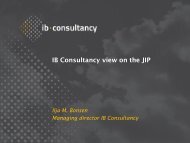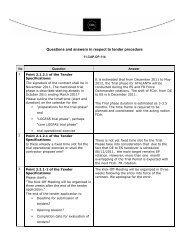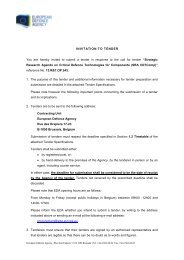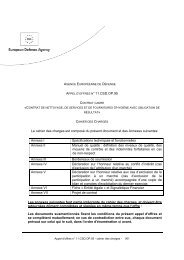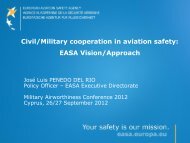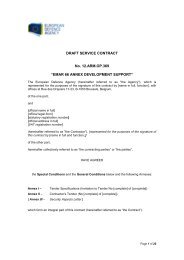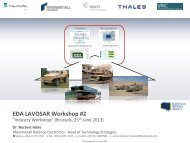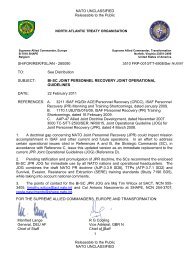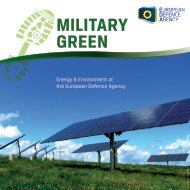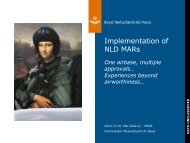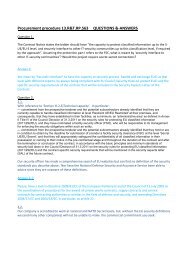capability development plan - European Defence Agency - Europa
capability development plan - European Defence Agency - Europa
capability development plan - European Defence Agency - Europa
You also want an ePaper? Increase the reach of your titles
YUMPU automatically turns print PDFs into web optimized ePapers that Google loves.
AN INITIAL LONG-TERM VISION<br />
FOR EUROPEAN DEFENCE CAPABILITY AND<br />
CAPACITY NEEDS<br />
Transal - Birao Airport © EUFOR Tchad RCA<br />
sustained are not the result of specific negligence.<br />
30. As the stream of civil technological advance broadens and quickens, so the traditional role of<br />
defence R&T as a motor of wider progress is reversed; technology will be “spun in” to defence more<br />
than “spun out”. Maintaining the military technological edge will therefore require better exploitation of<br />
civil technologies – and ever more rapid exploitation of technology, whatever its source, before the<br />
opponent works out how to adopt or negate it.<br />
31. The civil world of science and technology has another important lesson to offer – that technological<br />
advance will increasingly come as much from combining technologies as from linear <strong>development</strong> in<br />
one particular field. Yet no one institute, still less one person, can be competent across the broadening<br />
river of technology. Innovation will increasingly depend upon networks of excellent researchers<br />
collaborating to combine their expertise in different disciplines.<br />
32. In sum, our Armed Forces can expect from future science and technology the universal availability<br />
of communication and knowledge as well as new levels of precision of and protection against lethal<br />
effects. However, what they cannot expect are sustained unilateral advantages – be they measured<br />
against conventional opponents in classical state-to-state conflict or against asymmetric threats. The<br />
proliferation of knowledge remains endemic to open societies and a global economy.<br />
IMPLICATIONS FOR THE MILITARY CONTRIBUTION TO ESDP OPERATIONS<br />
33. What do the changes in the economic, social and military world around us – and those at home –<br />
mean for the future of ESDP operations in, say, 2025<br />
34. The typical ESDP crisis management operation will be expeditionary, multi-national and multiinstrument.<br />
The EU has recognised the need to be a global security actor. For such purpose it<br />
envisages a <strong>capability</strong> to project forces over strategic distances and to austere areas of operation.<br />
Interventions will be based on common objectives among Member States, thus sending a message of<br />
a shared EU commitment to resolve the crisis. Therefore, deployment of forces needs to be based on<br />
the principle of wide multi-nationality. Furthermore, the EU will increasingly utilise a comprehensive<br />
approach combining its hard and soft power instruments and coordinating civilian, military,<br />
governmental and non-governmental bodies to collectively achieve the necessary political effects.<br />
35. Indeed interventions will not necessarily involve fighting battles. The presence of multinational<br />
forces, backed by, and indeed symbolising, the collective political commitment of the Union, may well<br />
prevent hostilities from breaking out. Or they may help to stabilise a country or region after a political<br />
accord. Indeed, the scope of ESDP missions requires military contributions to be appropriately tailored,<br />
trained and readied to conduct a broad range of operations, in potentially austere areas and against<br />
diverse threats. In cases of intervention by force the main task will be to gain control of the dynamics of<br />
conflict, reduce its destructive power and break the cycle of violence. The objective is not “victory” as<br />
traditionally understood, but moderation, balance of interests and peaceful resolution of conflicts – in<br />
short, stability. That said, the level of force required to achieve such outcomes may, in some scenarios,<br />
be substantial.<br />
36. While the success of such interventions will be influenced by our military capabilities and actions, it<br />
will increasingly depend on our actions, or inaction, in a much broader range of domains such as the<br />
promotion of human rights, rule of law, security sector reform, good governance and the fight against<br />
international crime. It is unlikely that EU Member States’ forces undertaking a crisis management<br />
operation will be denied military success - but we may be denied overall mission achievement because<br />
we have failed to understand and <strong>plan</strong> adequately in this complex environment, or bring other crisis<br />
management instruments effectively to bear. Armed Forces are but one component of a wider,<br />
comprehensive and integrated approach to ESDP operations.<br />
37. In the information age, knowledge will be the vital resource in armed conflict. Commanders will be<br />
able to exploit opportunities and manage operational risk in an informed manner. But network and<br />
knowledge systems only provide the opportunity for quicker decision-making – they are not a sufficient<br />
condition for better decisions. Moreover, the benefits and the costs of the information age also apply to<br />
23<br />
FUTURE TRENDS FROM THE CAPABILITY DEVELOPMENT PLAN



